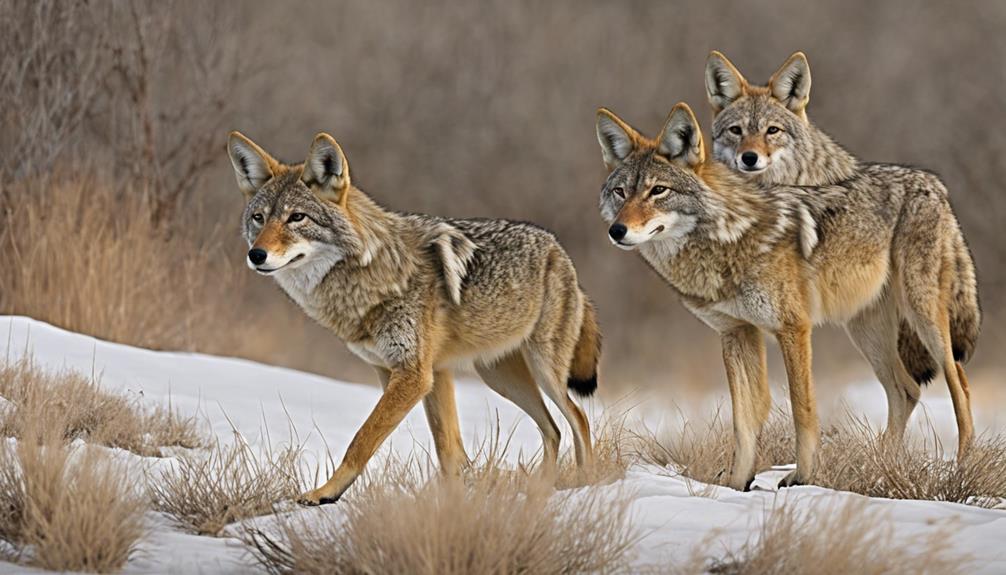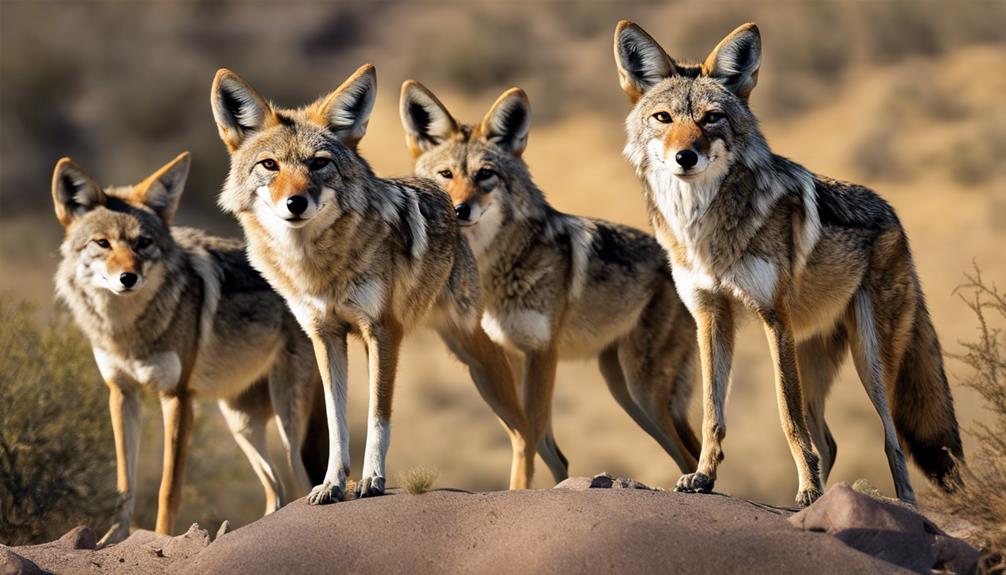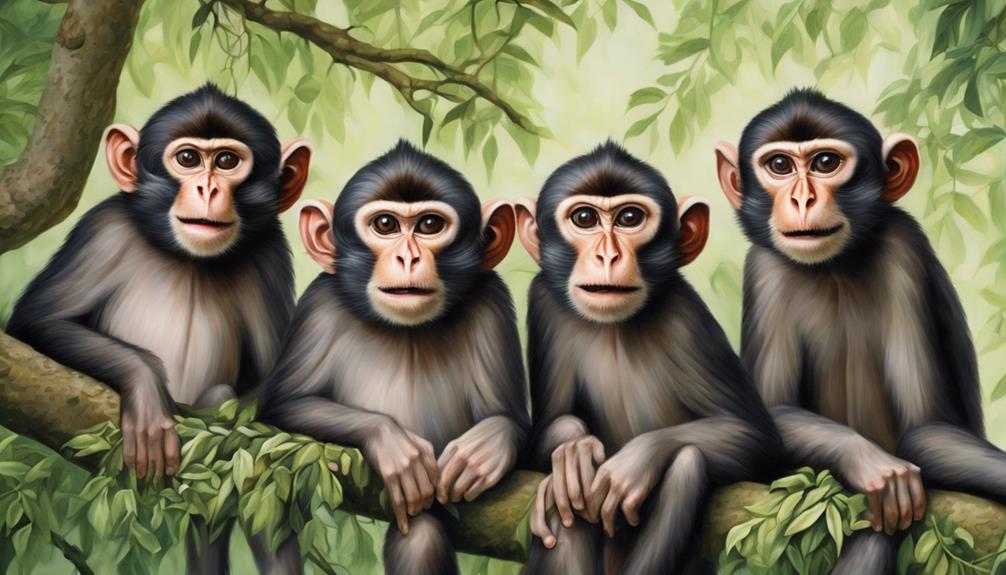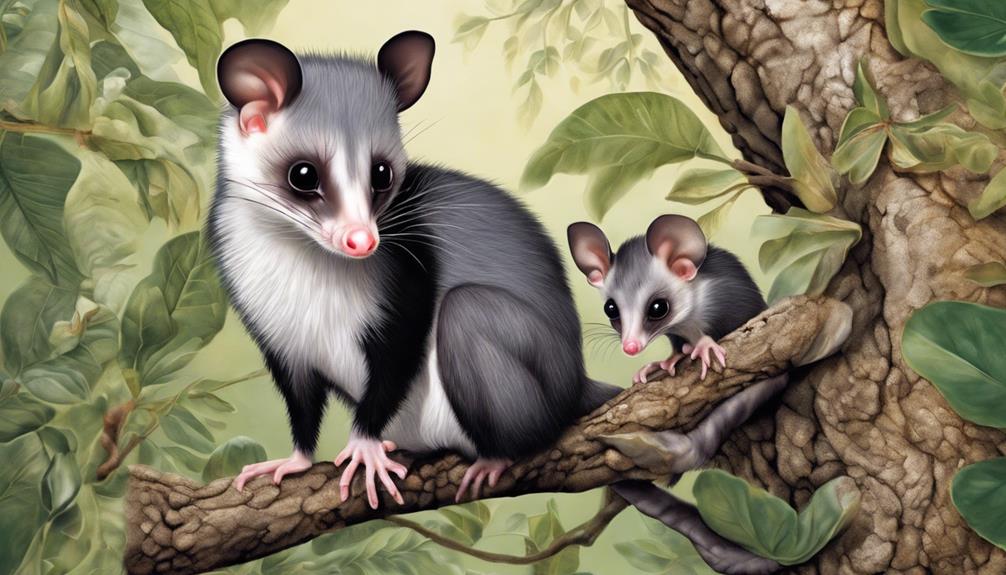I found five different types of coyotes: Western, Central U.S., Eastern, Central American, and Urban. Western coyotes inhabit a variety of habitats in North America. Central U.S. coyotes have four subspecies, such as the Texas plains coyote. Eastern coyotes in the Northeast have larger teeth, while Southeastern ones have red hints in their coat. Central American coyotes have numerous subspecies and can adapt well to various habitats in the region. Urban coyotes, crucial for managing rodent populations in cities, can sometimes become problematic when they become too comfortable around people. Interested in learning more about these intriguing coyote types?
Key Takeaways
- Western Coyotes: Northern, Mountain, Northwest coast, with unique adaptations in western North America.
- Central U.S. Coyotes: Plains, Texas plains, Mearns, vital to central U.S. ecosystems.
- Eastern Coyotes: Northeastern, Southeastern, possibly interbred with red wolves, thrive in diverse eastern environments.
- Central American Coyotes: Tiburon, Durango, Mexican, Colima, Belize, Honduras, and Salvador subspecies coexist in Central America.
- Urban Coyotes: Adapted to urban environments, control rodent populations, important for urban ecosystem balance.
Western Coyotes
Western Coyotes, with their diverse subspecies spread across western North America, exhibit unique characteristics and adaptations suited to their respective habitats. From the northern coyote ranging from central Canada to Alaska in the west to the mountain coyotes found in Northwestern states extending up through Canada and southern Alaska, each subspecies has distinct traits.
The darker Northwest coast coyotes inhabit the coastal regions of Washington and Oregon, while the California valley, San Pedro Martir, and Baja California Peninsula subspecies range from California down into Mexico's Baja California Peninsula. These coyotes have evolved to thrive in their specific environments, showcasing the adaptability and resilience of the species in diverse landscapes.
Understanding the intricacies of each subspecies provides valuable insights into the evolutionary processes that have shaped Western coyotes into the remarkable creatures they're today. As we explore further into the world of coyotes, we uncover a tapestry of biodiversity and ecological significance that enriches our understanding of the natural world.
Central U.S. Coyotes

Four distinct subspecies of coyotes are prevalent in the central United States, spanning states like Colorado, Oklahoma, and Texas. The Central U.S. is home to a diverse range of coyotes, each with its unique characteristics and habitats. Here are some fascinating facts about Central U.S. coyotes:
- The Plains coyote, found from central Canada down to Colorado, Oklahoma, and Texas, adapts well to various environments in the region.
- The Texas plains coyote, specifically inhabiting western Texas and eastern New Mexico, showcases significance in arid landscapes.
- Mearns coyotes, residing in areas of Arizona, Utah, New Mexico, and northern Mexico, exhibit adaptability to different terrains and climates.
Central U.S. coyotes play a significant role in the ecosystem of this region, showcasing their ability to thrive in diverse environments. From the open plains of Colorado to the arid lands of Texas, these coyotes demonstrate remarkable survival skills and resourcefulness.
Eastern Coyotes

Exploring the diverse range of Eastern Coyotes reveals unique genetic and physical adaptations reflective of their evolutionary history in the eastern United States. In this region of eastern North America, two distinct subspecies are found: the Northeastern coyotes and the Southeastern coyotes.
Northeastern coyotes, spanning from the Great Lakes to western New York, stand out with their larger teeth, adapted for hunting in various terrains like forests and grasslands. On the other hand, Southeastern coyotes, known for their larger size and hints of red in their coat, possibly due to interbreeding with red wolves in states like Illinois and Missouri. These genetic adaptations not only enhance their survival skills but also contribute to their distinct physical features.
The broader distribution of Northeastern coyotes compared to their Southeastern counterparts showcases how these animals have evolved differently to thrive in the diverse environments of the eastern United States.
Central American Coyotes

Central American Coyotes, boasting the largest number of subspecies in the region, exhibit remarkable adaptations to the diverse habitats and environments found throughout Central America and Mexico.
- Central American coyotes have the largest number of subspecies, with seven distinct types found in the region.
- The Tiburon coyote is unique as it only inhabits the island of Tiburon off the west coast of Mexico.
- Six subspecies in Central America are almost indistinguishable from each other due to overlapping populations.
In Central America, populations of Durango, Mexican, Colima, Belize, Honduras, and Salvador subspecies coexist, showcasing the adaptability of these creatures to a wide range of habitats and environments. The overlapping populations of these distinct types of Central American coyotes reveal their ability to thrive in various conditions, from dense forests to arid plains.
Studying these coyotes provides valuable insights into how wildlife adapts and evolves to survive in dynamic ecosystems, making them a captivating subject for exploration in the field of biodiversity and conservation.
Urban Coyotes

Adapting to urban environments, coyotes have learned to coexist with humans in cities and suburbs. These urban coyotes are essential feeders, scavenging for food in various sources like garbage cans and pet food left outdoors. Due to their proximity to human activities, urban coyotes may display bolder behavior compared to their rural counterparts. Surprisingly, these coyotes play a crucial role in urban ecosystems by helping to control rodent populations, acting as a form of natural pest control.
However, conflicts can arise when urban coyotes become habituated to human food sources, losing their fear of people. This behavior can lead to negative interactions between humans and coyotes, potentially posing risks to both parties. It's essential for urban residents to understand how to coexist peacefully with these wildlife neighbors, including securing potential food sources and avoiding direct contact. By respecting the boundaries and habits of urban coyotes, we can foster a safer and harmonious environment for both humans and wildlife in urban settings.
Frequently Asked Questions
Are There Different Type of Coyotes?
Yes, there are various types of coyotes, each with unique adaptations and characteristics. They vary in size, color, and behavior, reflecting their environments. Understanding these distinctions can provide valuable insights into the diverse world of coyotes.
What Did Lewis and Clark Say About Coyotes?
Lewis and Clark described coyotes as 'barking wolves,' marveling at their adaptability and resourcefulness in the wild. Their encounters painted a vivid picture of these cunning creatures' interactions with nature, shaping early scientific understanding.
What Is the Biggest Threat to Coyotes?
The biggest threat to coyotes is habitat loss due to urbanization, agriculture, and human persecution through trapping, shooting, and poisoning. Competition and hybridization with other canid species also endanger their genetic integrity, while disease outbreaks and climate change further impact their survival.
How Many Coyotes Are in the World?
I can't pinpoint the exact number of coyotes worldwide, but estimates suggest there are 2 to 3 million in North America alone. These adaptable creatures thrive in diverse environments, from Central America to northern Alaska.
What Are the Different Types of Coyotes and Their Characteristics?
The unique white coyote husky mixes are a fascinating combination of two distinct species. These hybrids feature the physical characteristics of both coyotes and huskies, with their unmistakable white coat standing out. This unique blend results in coyotes with a stunning appearance and a mix of traits that showcases the diversity found in nature.
Conclusion
To sum up, exploring the different types of coyotes has opened my eyes to the vast diversity within this species. From the Western Coyotes of the open plains to the Urban Coyotes adapting to city life, each type has unique characteristics and behaviors.
Just like humans, coyotes have evolved to thrive in various environments, showcasing the resilience and adaptability of nature. By understanding these differences, we can learn to coexist with these fascinating creatures in a harmonious way.










